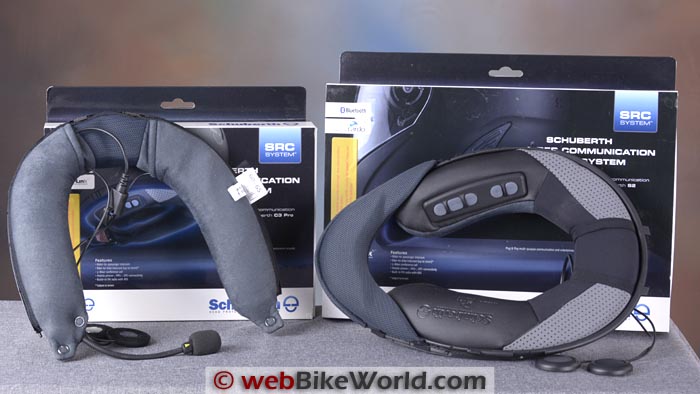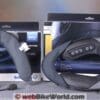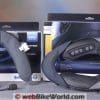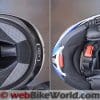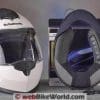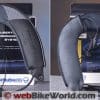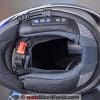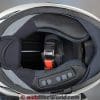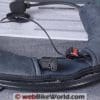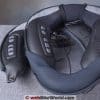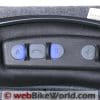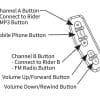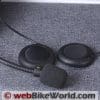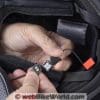The SCHUBERTH SRC-S (SCHUBERTH Rider Communications System) is an updated intercom.
It fits the SCHUBERTH C3 Pro (review) and the SRC for theSCHUBERTH S2 (review).
Both of those, in turn were an update for the original SRC we reviewed in 2010 for the SCHUBERTH C3 (review)..
Wow! That’s a big list of reviews!
But SCHUBERTH helmets are very popular in Europe, the U.S.A. and the rest of the world and there’s a lot to talk about.
This review consists of updates to our original SRC-S review.
It will note specific changes to the SRC System mounted in the SCHUBERTH C3 Pro and S2 helmets.
The SRC System is a unique motorcycle intercom system, designed by Cardo Systems with SCHUBERTH to fit various SCHUBERTH helmets.
The system places all of the intercom components and control buttons into a replacement neck roll or “collar” that fits the C3 Pro, the S2 and other SCHUBERTH (only) helmets.
Unfortunately, there is no single SRC standard system that will fit all SCHUBERTH helmets.
Not only do you have to choose an SRC specific for your particular SCHUBERTH helmet, the correct size SRC-S to match the helmet shell size is also required.
This surely increases the cost and stocking complexities for the retailers, possibly accounting for a portion of the stiff price tag for an SRC-S.
For example, the SRC-S for the C3 Pro and the separate SRC for the SCHUBERTH S2 both list for $429.00.
That’s more than you’d pay for some high-end helmets.
Add that to the already-expensive cost of the C3 Pro ($769.00 to $829.00) or an S2 ($599.00 to $699.00) and we’re up into stratospheric price levels compared to the cost of other helmets and intercom systems.
One of the main benefits of the SRC System is that it’s more or less a “bespoke” fit to the SCHUBERTH helmet.
The SRC collar easily swaps with the stock S2 neck roll, although fitting the SRC to the C3 Pro requires deft hands and a lot of patience, as we and many others have discovered.
But once the SRC-S is installed, it provides Cardo Scala Rider type intercom technology that seems to be the equivalent of a Cardo Scala Rider G9 (review).
That includes the “Click to Link” instant pairing feature and FM radio.
The difference — or one difference at least — is that the SRC-S connects to a built-in antenna hidden in the SCHUBERTH helmet shell.
This does provide excellent radio reception that’s above and beyond most other clip-on intercom systems with an FM radio built in.
But…we can’t help but think that the SRC has been overtaken by the incredibly rapid progress in motorcycle Bluetooth intercoms that has taken place over the last few years.
Seemingly every month a new motorcycle intercom system is released and this year we’re seeing Bluetooth 4.0 with multiple pairings that allow voice, music and GPS instructions to be heard simultaneously.
It also allows music sharing between intercoms; 1 kilometer plus range and even “universal intercom” pairing with other brands of intercoms.
The current SRC Systems do not have these features, and that points to one of the problems with a dedicated helmet intercom system — it’s difficult for the helmet manufacturers to keep up with the trends and technology advancements.
Nevertheless, the SCHUBERTH SRC System does have several advantages, so let’s take a closer look.
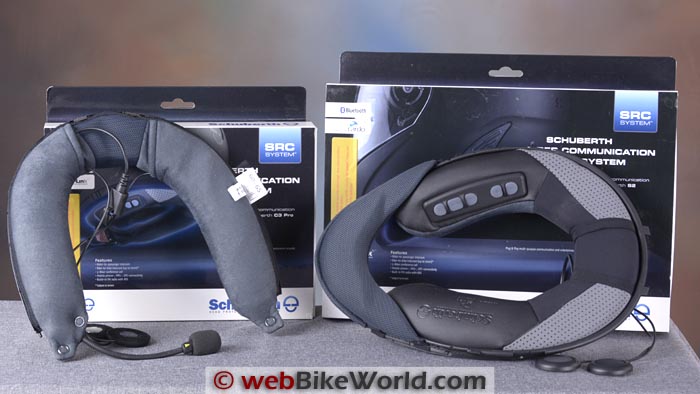
The SCHUBERTH SRC System
Since all SCHUBERTH SRC Systems are fairly similar, we’ll cover only some of the differences and updates to the SRC-S for the C3 Pro and S2.
SCHUBERTH designed a removable and replaceable neck roll or “collar” for their helmets, which allows the standard neck roll to be replaced with an SRC System.
The SRC System has all of the electronics, buttons and batter embedded inside.
The only differences that a sharp eye would notice between a stock helmet and an SRC-S equipped helmet are the control panel along the left-hand side.
Also the charging/input USB connector and the connector for the internal helmet antenna.
The SRC Systems have the Cardo spoken status announcements and limited voice control.
The system gives priority to the cell phone or GPS instructions, then the intercom, then an A2DP audio source, then the built-in FM radio and finally the line-in port if used.
It also has VOX and limited multiple system-to-system connectivity functionality.
Other features of the SRC for the C3 Pro and S2 include:
- HFP (Hands-Free Protocol), stereo A2DP and AVRCP profiles to control phone calls, GPS and music streaming via Bluetooth at up to 10 meters (33 feet).
- Two to three pairings for bike-to-bike, rider-to-passenger or intercom conference calls (does anybody ever use that feature?) with other SCHUBERTH SRC Systems.
- Range of approximately 300 meters (1,000 feet) in Full Duplex mode.
- Cardo “Click-to-Link” capability, which can be switched on to allow for spontaneous intercom pairing and communication with any nearby SRC that also has the system switched on.
- Built-in FM Radio with station searching and presets.
- Auxiliary inputs for audio devices, etc.
- AGC (Automatic Gain Control) to increase or decrease sound volume depending on ambient noise.
- VOX for phone calls.
- Spoken status announcement assistance.
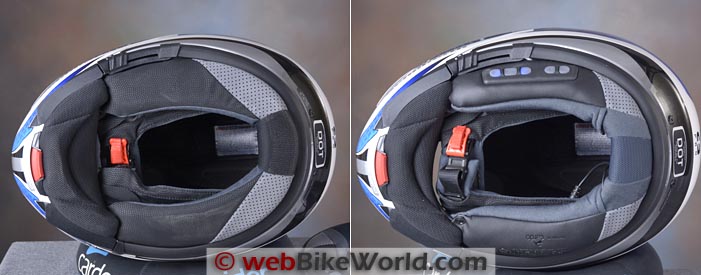
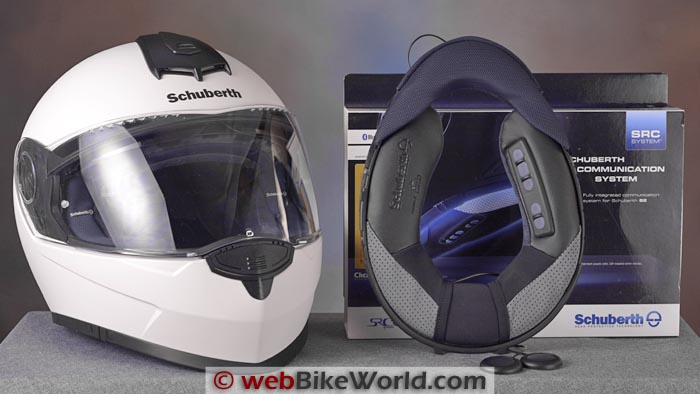
Installing the SCHUBERTH SRC System on the S2
Installing the SRC on the SCHUBERTH S2 is a snap — literally.
Since it’s a full-face helmet, the neck roll on the S2 is one piece and easily removable by simply pulling it away from the helmet shell, starting at the front or back.
You’ll have to go fishing to find and connect the special antenna adapter (and don’t try to pair the SRC until you do this because it won’t work; see the “On the Road” section below).
It’s semi-hidden under the right side of the helmet, up around the flocked covering on the EPS liner.
Our S2 is one of the original ECE versions and it does not have the red tab marking the antenna connector, but all of the later S2 helmets will have the red tab, making it easier to find the connector.
The connector will only mate one way, with both wires pointing down.
Then make sure you snap the red tabs over both halves to hold it tight.
I fit the rubber protector that covers the helmet half of the connector over the assembly just to make sure, then it can be fitted down into the channel recess at the rear of the S2, between the EPS and helmet shell.
Next, snake the speakers up behind the liner and into the special pocket molded in the EPS.
There are two stick-on hook-and-loop pads in the box which can be fastened to the speaker pockets first, then place the speakers on the pads.
The kit also includes two thick spacers that will fit between the speakers and the stickies to push the speakers out closer to your ears, if you find that necessary.
It’s important to get the speakers as close as possible to your ears for best results.
The speaker position can vary enough to locate the speakers half-way up the ear, so you might want to get a feel for where the speakers should go in their pockets before they are installed.
The microphone on the S2 is a wired type and it also has a stick-on hook-and-loop pad in the box. Wear the helmet first and feel with your fingers where your mouth is, then stick on the pad.
Try to get the mic placed as close as possible to the center of your mouth for best results.
All of this really only takes a few minutes on the S2, it’s about the same as installing a “normal” modular-style intercom system.
Easier, actually, because you don’t have to mess with an intercom helmet mount.
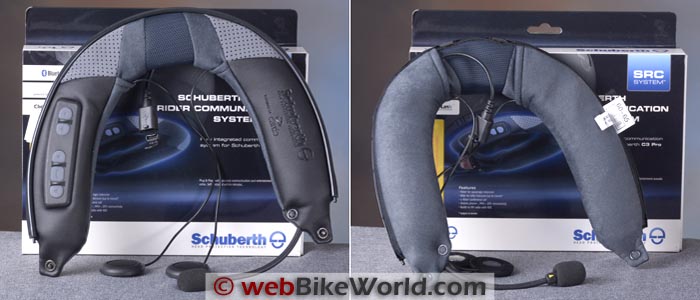
Installing the SCHUBERTH SRC System on the C3 Pro
Read the C3 Pro SRC System owner comments on some of the forums or SCHUBERTH retailers and you’ll find many people who love the SRC System but not the installation.
Installing the SRC-S in the flip-up C3 Pro seems more complicated and difficult than it should be due to the design of the helmet.
Two of us struggled with it for some time and we still made the classic error that seems to plague many owners: breaking one of the pins on the C3 Pro neck roll.
[UPDATE: See our article on Fixing the Broken Pin on a SCHUBERTH C3 or C3 Pro Neck Roll]In the end, you’ll need a ton o’ patience and make sure you’re very careful when removing the C3 Pro neck roll. Then you need twice as much of both to get the SRC System collar installed.
It just doesn’t snap in like it does on the S2, and this is something SCHUBERTH needs to work on — hopefully in the next iteration of the C-series?
The best tip we discovered after a couple of attempts at removing the stock neck roll and installing the SRC-S is to start at the rear of the helmet and work your way around on both sides.
The owner’s manual doesn’t add much in the way of tips but that one seems to work.
Just be careful of the pins in the front and push the plastic ring that surrounds the neck roll/collar until you get it to snap in under the shell all around the perimeter.
And here’s another tip: if you start to get frustrated before the job is completed, put everything down and go do something else and cool off.
It took us about 3 tries before we finally did get the SRC installed (and the speakers).
The mic on the C3 Pro SRC System is a boom type and it’s a bit of a curiosity because it comes out of the right side of the SRC neck roll, rather than on the left like most modular intercom boom mic systems.
Once you do get either of the SRC Systems installed in the helmets, you’re all set to learn how to use ’em.
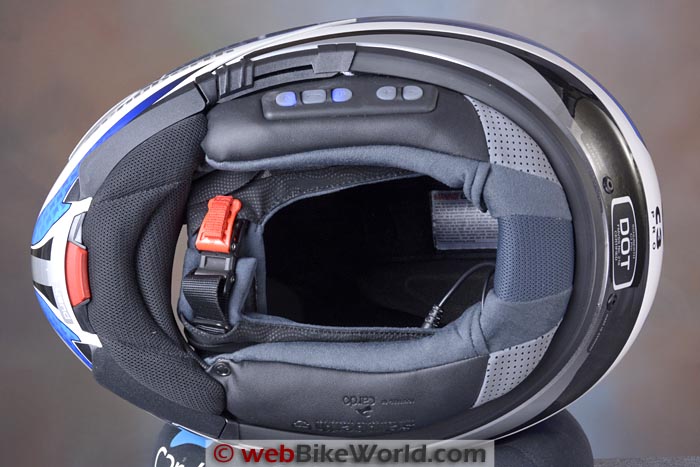
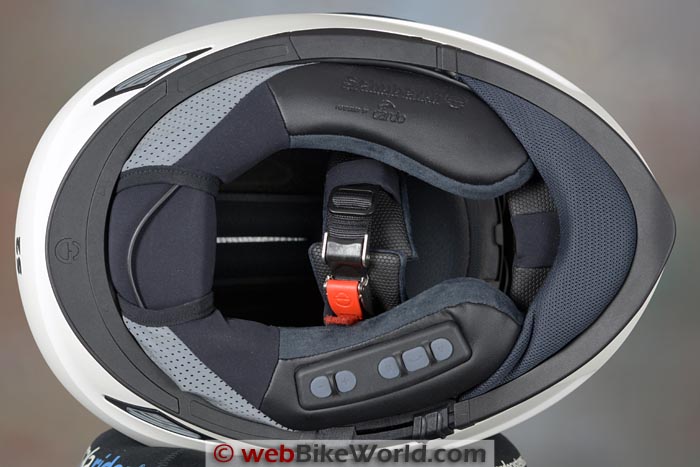
SRC Owner’s Manual Notes
By the way, the installation procedures are described in the owner’s manuals.
But the SCHUBERTH websites — both the U.S. and European versions were having connectivity problems over the last couple of weeks.
We have not been able to get consistent page loads and some links just don’t work.
For example, we have not been able to successfully register either of the SRC Systems, so we couldn’t get the latest firmware (although SCHUBERTH said ours had the most recent updates).
There’s apparently some kind of app that allows the owner to change or set some of the configuration.
But we couldn’t access that either because we couldn’t register the systems (and tried it on both the U.S. and European SCHUBERTH websites).
And we also could not find the SRC-S owner’s manual for the S2 on the U.S. website. Click on “Support” and then “SRC-System” and only the C3 Pro SRC manual is listed.
So at this point, you’re better off going to this link on the SCHUBERTH Germany site, which has the SRC System and also SCHUBERTH helmet owner’s manuals for each of the SCHUBERTH helmet types (in .pdf format).
It’s not clear why this same list format isn’t available on the SCHUBERTH USA website?
We definitely, positively recommend reading the SRC owner’s manual several times before you take the SRC-S out of the box.
The manual includes all of the information you’ll need (in several languages), but the layout is a bit haphazard, so it may take a few careful readings before everything becomes clear.
Indeed, the two of us had several very careful read-throughs while we had the installed intercoms in the helmets in front of us to figure out how everything works.
That includes right through initial pairing to smartphone Bluetooth pairing, making and receiving calls, using the FM radio, streaming music and changing options and features.
It’s important to understand all of the features and know where the buttons are and what the correct button-pushing sequences are before you go out on a motorcycle, because you certainly do not want to be fussing with this while you’re trying to pilot a bike!
Also, wear the helmet in the house and practice going through all of the button-pushing sequences you’ll need on the road.
That will help you learn where the buttons are — underneath and sometimes difficult to find by touch when wearing gloves — and what they do.
It will also help you to develop some “muscle memory” about where each button is located.
All of this background work will pay off in the end. I’ve been wearing the S2 with the SRC System installed for the last week or so and although I had my doubts at first, I found that after a while I started to know exactly where each button is located.
Kind of like playing a piano without having to look at your fingers and the keys.
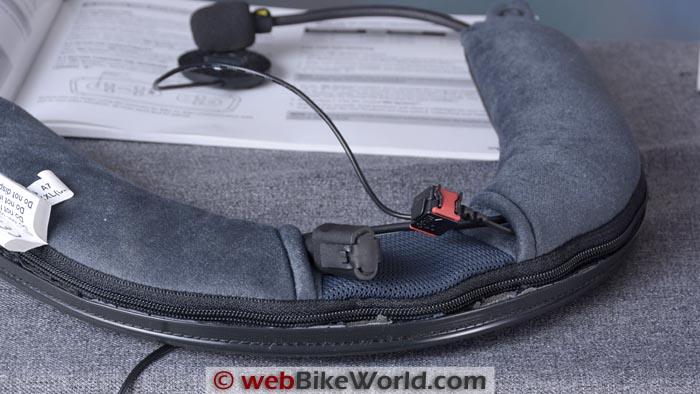
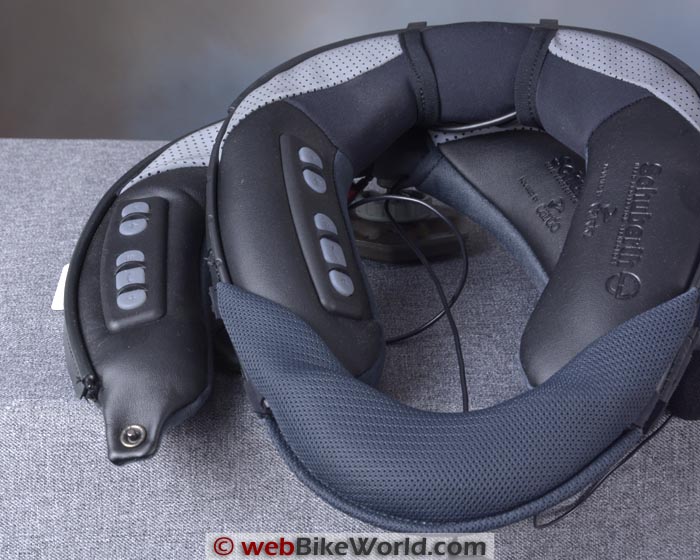
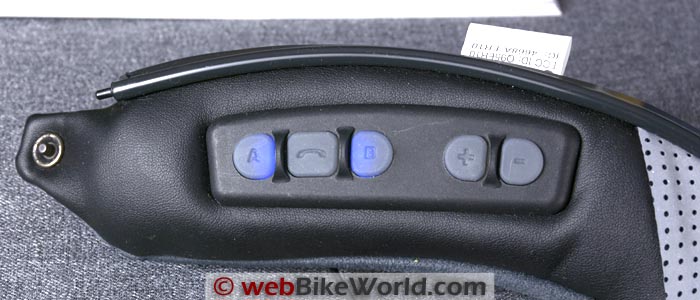
SRC-S Pairing
Once we installed the SRC in both helmets and played with the systems and understood the button pushes, the system works very nicely.
As mentioned earlier, it’s important to spend some time with the owner’s manual and understand how all of the features work and which buttons to push before taking the SRC-S out on the road.
The systems paired easily with each other.
And once the antennas were properly connected during the installation, we were able to pair the SRC with the only other Cardo Scala Rider system we have on hand, one of the new Cardo SHO-1 intercoms (review).
Note that the SRC-S antenna must be connected to the antenna in the SCHUBERTH helmet before the SRC-S can be paired with other Bluetooth devices or another SRC System.
This baffled us at first because we first tried to get the systems to pair before installing them the helmets, but they wouldn’t pair.
An email to SCHUBERTH support (which was very responsive, by the way) told us:
“Without the antenna connected, the SRC System will allow a Bluetooth connection to a GPS or mobile phone, provided that the devices are very close to each other, but it will not allow intercom connectivity even if the units are immediately next to one another.”
FM Radio Reception Notes
The benefit of having the antenna in the helmet is improved FM radio reception and we noticed this right away.
The radio reception in the SRC isn’t perfect, but it’s much better than most or even all of the other intercoms we’ve reviewed that have an embedded FM radio.
The systems will search or scan for radio stations and up to 6 station presets can be stored.
While other FM radio equipped intercoms we’ve reviewed struggle to bring in 2-3 stations in our radio station rich local environment, the SRC-S has dozens to choose from, including all of the low-frequency college and public radio stations.
This is also where a careful read of the owner’s manual will pay off, because the radio uses the B button on the control panel, along with Volume Up and Volume Down to do the searching.
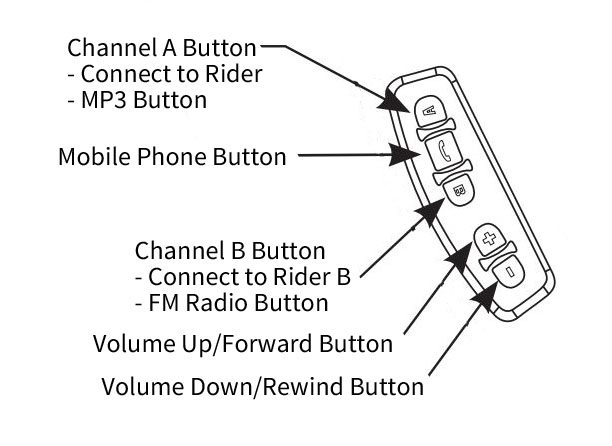
Here’s a “cheat sheet” we made up by reversing the line drawing of the SRC-S control panel to help illustrate where the buttons from the rider’s perspective as the control panel is mounted on the lower left side of the helmet. In other words, this illustrates the button locations once you’re wearing the helmet. SRC-S owners may want to print this and use it for reference.
SRC-S Intercom Range Notes
Despite the antenna, the range between two SRC Systems in intercom mode is not quite the equivalent of some of the latest high-end intercoms.
We found that we could get line of sight at about 1/4 mile or so. But actually, for most riding situations, this is fine.
As always, this is very difficult to determine in our geography, due to the hills and curvy roads.
But let’s just say it’s fine for reasonable bike-to-bike and, of course, rider-to-passenger.
You’re almost never going to get the claimed range for intercoms or two-way radios unless you’re riding on a flat desert.
When the intercoms are out of range, there’s a bit of static as they try to reconnect and many intercom owners complain about this reconnect sound, which is common with motorcycle intercoms no matter the brand.
I usually press the button to end the intercom conversation (the A or B channel on the SRC, whichever one you used to pair the intercoms) and then press the button again later when we’re back in range and I see the other rider.
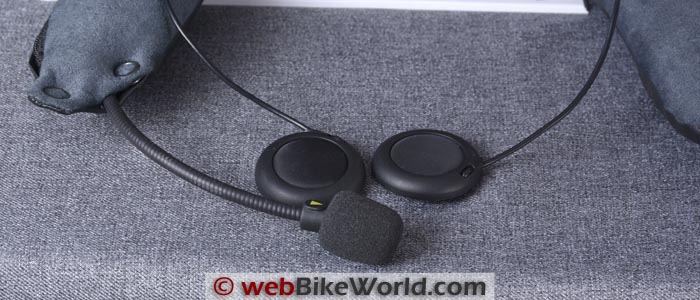
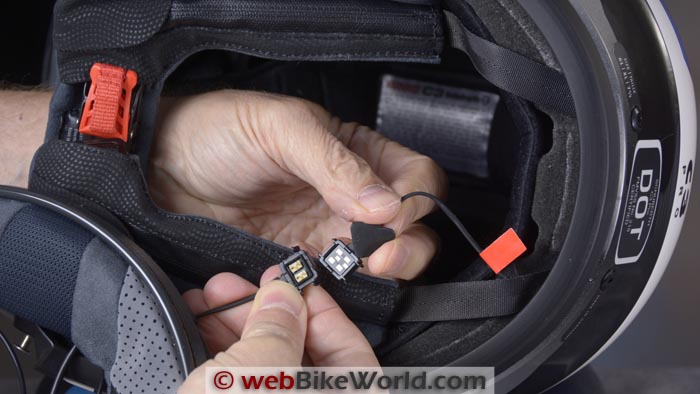
Volume and AGC Notes
The maximum volume levels with the SRC-S aren’t quite up to the latest standards.
We estimate maximum volume at about 85% of the best of the current intercom systems.
Those include the Interphone F5MC (review), the Cardo SHO-1 (review) or the new Sena 20S (review), all of which higher volume levels, better clarity and improved speaker response also.
Note that you can’t swap out the SRC speakers for a better pair either.
We always wear ear plugs when riding, even when reviewing intercom systems.
And both the music and especially cell phone calls are difficult to hear when using the SRC-S in the S2 (which is a louder-than-expected helmet) and the SRC-S sound levels are marginal in the C3 Pro.
You know when you’re constantly pushing on the Volume Up button for more volume and not getting it, then the system could use improvement.
The AGC (Automatic Gain Control) doesn’t help, because it seems, well, too automatic. We couldn’t find a way to disable it or change the sensitivity levels (perhaps there’s a way?).
When riding behind a windscreen, the AGC lowers the highest volume just when we wanted more.
Apparently, it senses through the mic the volume and type of ambient noise to adjust the speaker volume up or down.
We noticed that if we stood up on the foot pegs with the helmet in the wind, the SRC-S speaker volume increased and we wish we could cancel the AGC and get the maximum volume always.
“Hidden” Configuration Menu
There’s a semi-hidden configuration system setting menu via spoken status announcements; it’s “hidden” in section 4.5 of the owner’s manual.
Press and hold the A and B buttons for 3 seconds while the system is in standby (i.e., no music playing, no intercom conversations, etc.) and it will (slowly) walk (speak, rather) you through the configuration menu.
Conclusion
The SCHUBERTH SRC System is expensive, there’s no doubt about it. Installing the SRC-S in the C3 Pro is a bit of a chore, but easy on the S2.
Once you overcome that, the SRC-S is a nice “motorcycle communications system” or intercom (as they’re commonly called) that works well and adds no visible hardware to the helmet.
In fact, the “hidden” appearance of the SRC-S is apparently a big plus for many owners, as is the internal antenna in the newer SCHUBERTH helmets
The SRC System is slightly more difficult to learn and use than some other motorcycle communication systems, although in all fairness, all of the modern high-end intercom systems are more difficult to learn and use than the basic systems.
The SRC-S does feel a bit dated at this point however when compared to the newest motorcycle communication systems.
And, obviously, the SRC-S fits a SCHUBERTH helmet only, while other “clip on” intercom systems can be moved from one helmet to another.
The price of the SRC-S may be difficult to overcome for many.
You can buy, for example, a Sena SMH5FM (review) for around $120.00 and although that’s a bit of a chalk-and-cheese comparison with the SRC-S.
The SMH5FM still beats many or most of the high-end intercom systems that were available just a couple of years ago — all of which cost a heck of a lot more.
Or, you can buy two Sena SMH10B intercoms (review) for less than the cost of one SRC System.
So it’s a little difficult to make an overwhelming value proposition for the SRC-S, but if you are a die-hard SCHUBERTH fan or if you want the seamless SCHUBERTH integration that the SRC-S provides.
Or if you’re planning on keeping your C3 Pro or S2 for a few years, then the SRC System is the way to go.
Also: SCHUBERTH Neck Roll Broken Pin Fix
Owner Comments and Feedback
See details on submitting comments.
From “T.H.” (October 2016): “I bought one of these at the same time as buying a C3 to replace my five-year-old C2 (which I had fitted with a Scala Rider).
Fitting the SRC was a little fiddly, but didn’t take long.
I no longer bother turning it on, and am considering taking it out and putting the original collar back in, swapping the Scala Rider from my old helmet.
I cannot feel which button is which with my gloves on, making it unusable.
I was talking to a friend last night who has exactly the same problem with his S2 on a BMW GS1150.
He had to turn off the voice activation because it kept changing things he hadn’t asked for. He also only uses it for listening to his GPS instructions.
I find shutting the front of the helmet difficult. I’m not sure what gets in the way, probably the mic, but it almost never shuts first time.
I consider it a total waste of money, and I very much regret buying it (SCHUBERTH C3 on a Honda ST1100 Pan European).”
Editor’s Note: We have found that the rotating flip-up front on the SCHUBERTH C3 and C3 Pro can be difficult to close with or without the SRC installed. It seems to be an endemic problem with this helmet design.
From “R.K.” (April 2016): “I would like to share my experiences with the SRC.
The functionality is described extensively, yes I would like to have simultaneous connection with GPS and mobile phone.
But I accepted that when I bought the system 4 years ago. (I drive 4000 km per year in sunny conditions).
Appreciate the integration of helmet and communication set. My biggest concern is the poor quality of the system.
Had to go back to a service point already twice for a bad connection of speakers.
Repaired under guarantee although outside period. At the moment the battery is failing. Time to reconsider the SRC and Cardo choice.”
UPDATE: (June 2016) – “Wrote a letter to the SCHUBERTH company with my complaints on the SRC. Had to return the set already to the dealer 3 times in 4 years and again a failing set.
They replied rather quick and via my dealer I received a new set. Problem is solved.”
From “E.M.” (July 2015): “I would like to share my thoughts on the SCHUBERTH SRC system for my C3 Pro.
The system is a good idea in principle being integrated and neat, however the execution is ordinary to say the least.
As you noted I found the installation most frustrating and yes those pins got broken despite care taken.
I have had my system nearly 2 years now and it is still frustrating to remove and install the collar when removing the helmet lining for cleaning.
On my unit the press studs fused with the cheek pieces and broke off from the collar so my collar is just sitting in it’s slot now.
The design is poor in that regards for installation and servicing of the helmet liners.
My other gripes are that there is no way of repairing the unit. I have a loose speaker wire which is annoying for the right hand side which should be a straight forward fix for an electronics technician.
Schuberth’s support has suggested sending it back to Germany via the dealer — a long way to go from where I live in Singapore to fix a loose wire (cost of shipping and repair would probably be more than the unit is worth.
This is also a plague for other things like the location pins — if they break you need to replace the whole unit which is a crazy situation for such small faults.
The other gripe I have is that you cannot pair both a phone and a GPS simultaneously so to use both devices at their best rather than relying on the GPS to be a intermediary for the phone and hence lose functionality and responsiveness.
This is poor considering the cost of the unit in the first place.
When it is in and working it is reasonably good although I would like to be able to install better quality speakers as the sound is not all that great for the price point.
Hope this feedback is useful and I hope that SCHUBERTH is listening to the feedback from its customers for what is costly high end product.”
From “A.S.” (August 2014): “First time over years I don’t agree with you. I got the SRC System for the C3 Pro and got nothing but troubles. Besides too bulky it was a real mess get the helmet’s jaw piece locked.
A few days ago I went to the south of Chile (here we are in winter) and the cold air flowed gently into the the helmet made the trip a torture.
After a few kilometers it becomes a security issue as well. Besides the cold and noisy, it was tight. I felt like hanging at the gallows.
I installed the regular collar back and all the nightmares are gone: the C3 is again easy the put on and remove, quiet, the jaw piece locks on the fly as it should and cold weather isn’t any more an issue.
Everything is like the good old times as it was before I bought this expensive piece of crab.
The only place I know for sure where the SRC belongs, is the dumpster. But never mind, it is not your fault, it got the SRC since some month ago.”
From “Y.L.” (August 2014): “Having both the C3 and the C3 Pro, both with their respective Bluetooth collars, I really enjoy the latest version for the C3 Pro. It got a richer fuller sound and far better reception for Bluetooth and Radio.
The AGC sensitivity, (and other adjustments like preset radio channels, VOX sensitivity levels etc.) can be changed via a downloadable PC software from Schuberth.
I ride a BMW R 1200 RT with a huge windscreen, and even if the sound level on the Bluetooth collar feels a bit soft sometimes when I stream music form my mobile, I have no problems hearing bike to bike communication or FM radio.
Being a former haring aid technician I always wear the best custom made full block earplugs.”
From “A.D.” (August 2014): “A year or so ago SCHUBERTH did a promo deal on this system and I bought one along with my S2.
I don’t really need an intercom, but i do listen to NPR while commuting (at an appropriate volume, of course) and the idea of an integrated FM radio system really appealed to me.
I was very disappointed with the execution and wound up returning it after a couple of weeks and may tries to get it to work satisfactorily. Some of the flaws were noted in your review, but not the worst ones.
The review stated that the system’s volume was on the low side. I’d go much further: in my opinion the volume was utterly inadequate.
Even cranked all the way up with spacers installed to press the speakers closer to my ears, the radio volume was not sufficient to be intelligible at anything above 35 mph.
The electronics inside the neck roll make it bulky and awkward, making it more difficult to get the helmet on and off.
By far the biggest issue, however, was that the neck roll would consistently pop out of place at the chin bar when removing the helmet. When I say “consistently” I mean every single time. Over and over and over.
Yes, it was installed properly, and yes, I was trying to hold it in place. This product needs further refinement to be usable.
I went back to my preferred setup, which is a pair of the outstanding Plug-Up S-plug earbuds and an iPod Nano.
I’m on my second pair (I stepped on the first pair – oops) and went for the iPhone version with its in-line mute and volume control.
This sits just below my chin strap, making it easy to mute the radio.”
Rick’s Reply: Perhaps the SRC-S was the incorrect size for your S2? The SRC-S comes in different sizes to match the helmet size. No problems at all with ours popping out, it’s in there tight as could be.


